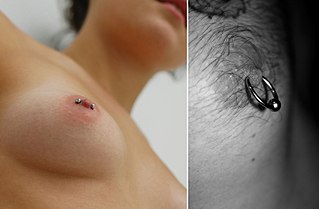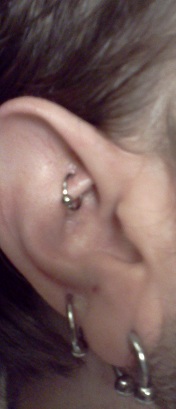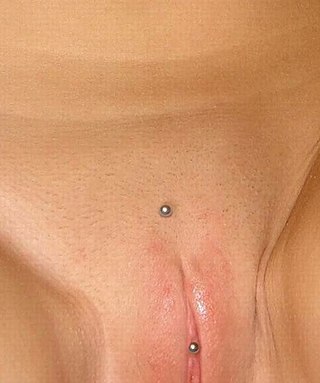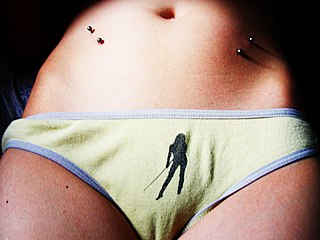
The Prince Albert (PA) is a penis piercing which extends from the urethra to the underside of the glans. It is one of the most common male genital piercings. The related reverse Prince Albert piercing enters through the urethra and exits through a hole pierced in the top of the glans.

A navel piercing is a type of piercing that penetrates the skin of the navel. It is most commonly located on the upper fold of skin but can also be affected underneath or around the edges of the navel. Healing usually takes around 6–12 months but varies person-to-person due to differences in physiology.

A clitoral hood piercing is a female genital piercing through the clitoral hood surrounding the clitoris. In addition to being an adornment, a clitoral hood piercing can enhance sexual pleasure during masturbation, foreplay and intercourse. In an empirical study at the University of South Alabama, the authors reported a positive relationship between vertical clitoral hood piercings and desire, frequency of intercourse, and sexual arousal. There are two main types of clitoral hood piercing: the vertical clitoral hood (VCH) piercing and the horizontal clitoral hood (HCH) piercing. As the names indicate, the difference is in the direction the piercing is oriented in the skin above the clitoris. Neither of these piercings penetrates the clitoris itself, although in common parlance they are sometimes called "clit" piercings. The deep hood piercing is a variation of the clitoral hood piercing that passes deeper through the clitoral hood.

A dydoe is a type of male genital piercing that passes through the ridge of the glans on the head of the penis. They are often done in pairs. Less often, a "king's crown" is where several dydoes are placed around the head of the penis. The jewelry is usually a 12 gauge, straight barbell with a ball on either end, although a ring may be used at a higher chance of rejection. A deep dydoe is one that uses a longer barbell and exits near the tip of the penis.

Genital piercing is a form of body piercing that involves piercing a part of the genitalia, thus creating a suitable place for wearing different types of jewellery. Nevertheless, the term may also be used pars pro toto to indicate all body piercings in the area of the anus, perineum, penis, scrotum, and vulva, including piercings such as anal, guiche, and pubic that do not involve perforation of genitalia. Genital piercings can be done regardless of sex, with various forms of piercings available. The main motive is beautification and individualization; in addition, some piercings enhance sexual pleasure by increasing stimulation. Pre-modern genital piercings is most culturally widespread in Southeast Asia, where it has been part of traditional practice since ancient times. Records of genital piercing are found in the Kama Sutra.

A nipple piercing is a type of body piercing, centered usually at the base of the nipple. It can be pierced at any angle but is usually done horizontally or, less often, vertically. It is also possible to place multiple piercings on top of one another.

Isabella piercing is a female genital piercing. This extremely deep clitoral shaft piercing starts below the clitoris and just above the urethra, and then goes up through the clitoral shaft and exits at the top of the hood.

A fourchette piercing is a female genital piercing. It is a piercing done at the rear rim of the vulva, in the area of frenulum of labia minora. Many women do not have a pinchable flap of skin in the area, and are not suited for this piercing. Otherwise, placement and piercing tends to be relatively easy.

The labia are the major externally visible portions of the vulva. In humans and other primates, there are two pairs of labia: the labia majora are large and thick folds of skin that cover the vulva's other parts while the labia minora are the inner folds of skin between the outer labia that surround and protect the urethral and vaginal openings.

A guiche piercing is a body piercing through the perineum. Guiche piercings are much more common in men than in women. Although a guiche normally runs perpendicular to the direction of the penis, lateral placements are possible. A series of guiche piercings in parallel to the direction of the penis is called a guiche ladder, and might commonly be seen as an extension of a frenum ladder.

A clitoris piercing is a genital piercing placed directly through the head (glans) of the clitoris itself. It is a relatively uncommon piercing by choice because of the potential for nerve damage, and because many may find it too stimulating to allow the constant wearing of a small ring or barbell. Most piercing studios will refuse to do a clitoral piercing. It is often confused with the more common clitoral hood piercing, which pierces only the hood covering the clitoral glans, allowing the jewelry to make only occasional contact with the most sensitive area.

A rook piercing is a perforation of the antihelix of the ear for the purpose of wearing jewelry. It is located just above the tragus on the ridge between the inner and outer conch with the piercing passing from the underside to the top of this ridge, differing from many ear piercings that essentially span between a "front" and "back" surface. Erik Dakota, a well known professional piercer and the individual responsible for originating and popularizing the rook piercing, is said to have named this modification after a shortened version of his first name. The piercing was first named in issue #4 of the magazine Body Play and Modern Primitives Quarterly around 1992 alongside the first printed reference to the industrial piercing, then termed "industrial ear project".

Piercing migration is the process that occurs when a body piercing moves from its initial location. This process can be painful or go unnoticed, until it has progressed. Given enough time, a ring may migrate entirely outside of the skin, although it may only migrate a small amount and come to rest.

A corset piercing is a body piercing that consists of multiple piercings in rows, usually on the back, with ribbon or string laced through to mimic the appearance of a corset. Two rows of bilaterally symmetrical piercings are performed and can be composed of as few as four piercings or as many as the length of the area being pierced and the vertical space between piercings will allow space for. Due to the difficulty and risks associated with permanently healing single surface piercings, most corset piercings are intended to be temporary.

Labia piercings are a type of female genital piercing. This piercing can be placed either through the labia minora or the labia majora. They are one of the simpler and more common genital piercings performed on vulvas, and are often pierced in symmetrical pairs. Like all genital piercings, depending on jewellery and placement, they may provide additional stimulation to one or both partners during sexual intercourse.

A Nefertiti piercing is a female genital piercing that is a combination of a vertical clitoral hood piercing and a Christina piercing. Healing can be lengthy given the amount of tissue the jewelry must pass through. Flexible bars are recommended by professional piercers because of the pressure that can be put on the piercing from passing through so much flesh.

Deep shaft piercings are piercings which pass through the penile shaft. They are most commonly seen in the form of deeply placed ampallangs, apadravyas, and reverse shaft Prince Alberts. They are more rare piercings due to associated pain, difficulty, bleeding and long healing times. Common placement is directly behind the head of the penis, but they can be placed farther back.

A Madison piercing is a body piercing going through the skin at the front of the neck. They are surface piercings, and have a high rate of migration and rejection. They have a long healing period, if they heal at all. The Madison piercing is named after the first person publicly associated with it, the porn star Madison Stone.

A hip piercing is a piercing in the pelvic area through the skin near the hip bone. Hip piercings are often done in couplets with one on each hip, but it is not unusual to see only one. Hips piercing are a type of surface piercing. Microdermals or skin divers can be implanted in the hip area to give a similar appearance.

In body modification, an implant is a device that is placed under the human skin for decorative purposes. Such implants may be subdermal or transdermal. In the context of body modification, some may consider injections of silicone and other substances a type of implant as well.




















